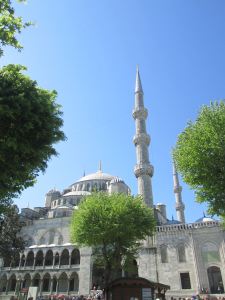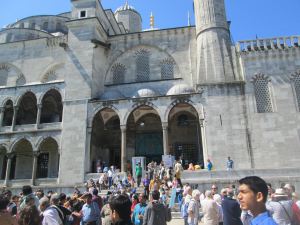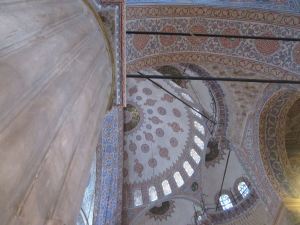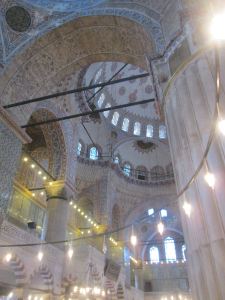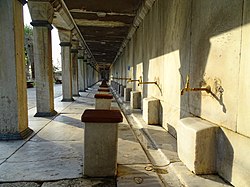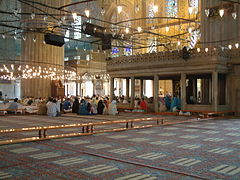See the previous post:
Trip 13: Post 3 …. ISTANBUL: Day 1 =10th May: Topkapi Palace Museum
______________________________________________________________________________
Note: I would like to share with you through these few words, photographs and hyperlinked websites, a 3 Dimensional experience as though you were actually there with us. Click on any photograph and it should enlarge to different size ….. at least half screen or size full screen. It will be clearer in detail than the photo on the post. It will be as if you were really there looking at the actual scene. You are an arm chair traveller with us.
______________________________________________________________________________
We were staying at the InterContinental Istanbul Hotel. By 9.00 am. we would all assemble in the hotel lobby to be transferred by a colour coordination group theme onto two buses which then took us to different places in Istanbul to see Byzantium history and art.
Day 2 =11th May in Istanbul, we went to see the Blue Mosque. The history of the mosque is as follows:
From Wikipedia, the free encyclopedia:
After the Peace of Zsitvatorok and the crushing loss in the 1604-1618 war with Persia, Sultan Ahmet I, decided to build a big mosque in Istanbul to reassert Ottoman power. It would be the first imperial mosque for more than forty years. While his predecessors had paid for their mosques with their spoil of war, Ahmet the First had to remove the funds of the Treasury, because he had not gained remarkable victories. It caused the anger of the ulema, the Muslim jurists. The mosque was built on the site of the palace of the Byzantine emperors, in front of the basilica Ayasofya (at that time, the primary imperial mosque in Istanbul) and the hippodrome, a site of significant symbolic meaning as it dominated the city skyline from the south. Big parts of the south shore of the mosque rest on the foundations, the vaults of the old Grand Palace.[3]
Architecture: The Sultan Ahmed Mosque has one main dome, six minarets, and eight secondary domes. The design is the culmination of two centuries of Ottoman mosque development. It incorporates some Byzantine Christian elements of the neighboring Hagia Sophia with traditional Islamic architecture and is considered to be the last great mosque of the classical period. The architect, Sedefkâr Mehmed Ağa, synthesized the ideas of his master Sinan, aiming for overwhelming size, majesty and splendour.[4]
Understanding Islam:
There are two denominations in Islam:
- Sunni Islam is a denomination of Islam which holds that the Islamic prophet Muhammad’s proper successor as Caliph was his father-in-law Abu Bakr. Sunni Islam primarily contrasts with Shia Islam, which holds that Muhammad’s son-in-law and cousin Ali ibn Abi Talib, not Abu Bakr, was his proper successor.
Sunni Islam is by far the largest denomination of Islam. As of 2009, Sunni Muslims constituted 87-90% of the world’s Muslim population. Its adherents are referred to in Arabic as ahl as-sunnah wa l-jamāʻah people of the tradition of Muhammad and the consensus of the Ummah” . In English, its theological study or doctrine is called Sunnism, while adherents are known asSunni Muslims, Sunnis, and Sunnites. Sunni Islam is the world’s largest religious body, followed by Roman Catholicism. Sunni Islam is sometimes referred to as “orthodox Islam”. The word “Sunni” is believed to come from the term Sunnah , which refers to the sayings and actions of the Islamic prophet Muhammad as recorded in the hadith.
The primary collections consisting of Kutub al-Sittah accepted by Sunni orthodoxy, in conjunction with the Quran and binding consensus, form the basis of all jurisprudence within Sunni Islam. Laws are derived from these basic sources; in addition, Sunni Islam’s juristic schools recognize differing methods to derive legal verdicts such as analogical reason, consideration of public welfare and juristic discretion.
- Shia Islam is the second-largest denomination of Islam: in 2009, Shia Muslims constituted 10-13% of the world’s Muslim population, and between 68% and 80% of Shias lived in four countries: Iran, Pakistan, Iraq, and India.
________________________________________________________________________________________
Exterior of the Mosque ....
Minarets
The Sultan Ahmed Mosque is first one of the two mosques in Turkey that has six minarets, the second one being the Sabancı Mosque in Adana. When the number of minarets was revealed, the Sultan was criticized for being presumptuous, since this was the same minarets number as at the mosque of the Ka’aba in Mecca. He overcame this problem by ordering a seventh minaret to be built at the Mecca mosque.
Minarets of the mosque.
Four minarets stand at the corners of the Blue Mosque. Each of these fluted, pencil-shaped minarets has three balconies (Called Şerefe) with stalactite corbels, while the two others at the end of the forecourt only have two balconies. Before the muezzin or prayer caller had to climb a narrow spiral staircase five times a day to announce the call to prayer.
Today, a public announce system is being used, and the call can be heard across the old part of the city, echoed by other mosques in the vicinity. Large crowds of both Turks and tourists gather at sunset in the park facing the mosque to hear the call to evening prayers, as the sun sets and the mosque is brilliantly illuminated by colored floodlights.
___________________________________________________________________________________________
Interior of the Mosque ….

…. Blue Mosque from Inside …. Many domes …. The mosque is popularly known as the Blue Mosque for the blue tiles adorning the walls of its interior.
I, Ken Aitken am wearing my orange hat. We bought this hat at a National Park Office when we were on our Kimberley Outback Tours – kimberleyoutbacktours.com in August 2009. We went 2,000 kms. in a 4 wheel drive air conditioned bus which included the 500 km. Gibb River Rd. When I wear it now, Harriet can easily pick me out in a great crowd of people.
…. Harriet culturally garbed ….
…. A model of the mosque …..
…. The stained glass windows
Interior view, featuring the prayer area and the main dome.
From Wikipedia, the free encyclopedia:
At its lower levels and at every pier, the interior of the mosque is lined with more than 20,000 handmade İznik style ceramic tiles, made at Iznik (the ancient Nicaea) in more than fifty different tulip designs. The tiles at lower levels are traditional in design, while at gallery level their design becomes flamboyant with representations of flowers, fruit and cypresses. The tiles were made under the supervision of the Iznik master. The price to be paid for each tile was fixed by the sultan’s decree, while tile prices in general increased over time. As a result, the quality of the tiles used in the building decreased gradually.[5]
The upper levels of the interior are dominated by blue paint. More than 200 stained glass windows with intricate designs admit natural light, today assisted by chandeliers. On the chandeliers, ostrich eggs are found that were meant to avoid cobwebs inside the mosque by repelling spiders.[6] The decorations include verses from the Qur’an, many of them made by Seyyid Kasim Gubari, regarded as the greatest calligrapher of his time. The floors are covered with carpets, which are donated by the faithful and are regularly replaced as they wear out. The many spacious windows confer a spacious impression. The casements at floor level are decorated with opus sectile. Each exedra has five windows, some of which are blind. Each semi-dome has 14 windows and the central dome 28 (four of which are blind). The coloured glass for the windows was a gift of the Signoria of Venice to the sultan. Most of these coloured windows have by now been replaced by modern versions with little or no artistic merit.
The most important element in the interior of the mosque is the mihrab, which is made of finely carved and sculptured marble, with a stalactite niche and a double inscriptive panel above it. It is surrounded by many windows. The adjacent walls are sheathed in ceramic tiles. To the right of the mihrab is the richly decorated minber, or pulpit, where the imam stands when he is delivering his sermon at the time of noon prayer on Fridays or on holy days. The mosque has been designed so that even when it is at its most crowded, everyone in the mosque can see and hear the imam.[5]
The royal kiosk is situated at the south-east corner. It comprises a platform, a loggia and two small retiring rooms. It gives access to the royal loge in the south-east upper gallery of the mosque. These retiring rooms became the headquarters of the Grand Vizier during the suppression of the rebellious Janissary Corps in 1826. The royal loge (hünkâr mahfil) is supported by ten marble columns. It has its own mihrab, which used to be decorated with a jade rose and gilt[7] and with one hundred Qurans on an inlaid and gilded lecterns.[8]
The many lamps inside the mosque were once covered with gold and gems.[9] Among the glass bowls one could find ostrich eggs and crystal balls.[10] All these decorations have been removed or pillaged for museums.
The great tablets on the walls are inscribed with the names of the caliphs and verses from the Quran. They were originally by the great 17th-century calligrapher Seyyid Kasim Gubari of Diyarbakır but have been repeatedly restored.[5]
….. Our leader from Voyages to Antiquity explaining to our group the Byzantine features of this Mosque …
________________________________________________________________________________________
Contents
Exterior
The facade of the spacious forecourt was built in the same manner as the facade of the Süleymaniye Mosque, except for the addition of the turrets on the corner domes. The court is about as large as the mosque itself and is surrounded by a continuous vaulted arcade (revak). It has ablution facilities on both sides. The central hexagonal fountain is small relative to the courtyard. The monumental but narrow gateway to the courtyard stands out architecturally from the arcade. Its semi-dome has a fine stalactite structure, crowned by a small ribbed dome on a tall tholobate. Its historical elementary school (Sıbyan Mektebi) is used as “Mosque Information Center” which is adjacent to its outer wall on the side of Hagia Sophia. This is where they provide visitors with a free orientational presentation on the Blue Mosque and Islam in general.[11]
A heavy iron chain hangs in the upper part of the court entrance on the western side. Only the sultan was allowed to enter the court of the mosque on horseback. The chain was put there, so that the sultan had to lower his head every time he entered the court to avoid being hit. This was a symbolic gesture, to ensure the humility of the ruler in the face of the divine.[11]
Pope Benedict XVI’s visit and silent meditation
Pope Benedict XVI visited the Sultan Ahmed Mosque on 30 November 2006 during his visit to Turkey. It marks as only the second papal visit in history to a Muslim place of worship. Having removed his shoes, the Pope paused for a full two minutes, eyes closed in silent meditation,[13] standing side by side with Mustafa Çağrıcı, the Mufti of Istanbul, and Emrullah Hatipoğlu, the Imam of the Blue Mosque.[14]
The pope “thanked divine Providence for this” and said, “May all believers identify themselves with the one God and bear witness to true brotherhood.” The pontiff noted that Turkey “will be a bridge of friendship and collaboration between East and West”, and he thanked the Turkish people “for the cordiality and sympathy” they showed him throughout his stay, saying, “he felt loved and understood.”[15]
Gallery
-
A short movie showing details of the Blue Mosque.
- __________________________________________________________
- See the next post:
Trip 12: Post 6 …. GREECE: Day 4 = May 12th May … Dardanelles and Mt. Athos
- __________________________________________________________





